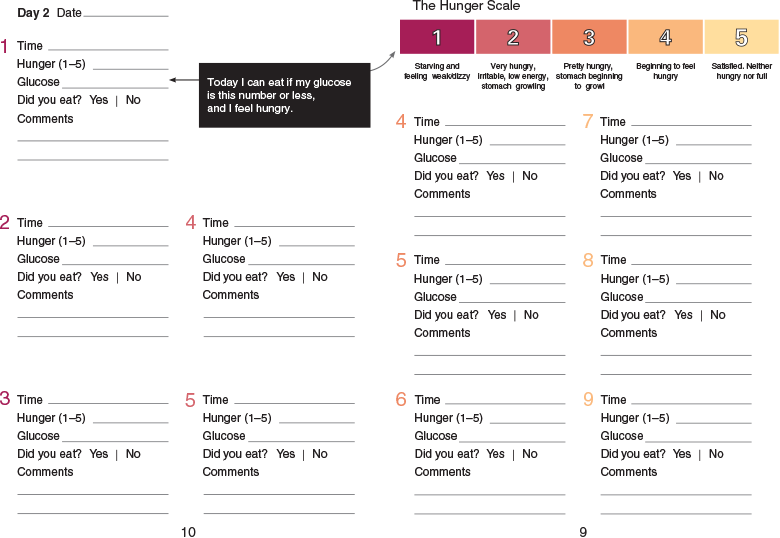Translating hunger training research to primary health: a qualitative study of nurse attitudes towards a novel weight management intervention
Jennifer T. Gale 1 , Aimee L. Ward 1 , Willemijn E. de Bruin 1 , Rachael W. Taylor 1 , Michelle R. Jospe 1 21 Department of Medicine, University of Otago, PO Box 56, Dunedin 9054, New Zealand
2 Corresponding author. Email: michelle.jospe@otago.ac.nz
Journal of Primary Health Care 12(1) 79-87 https://doi.org/10.1071/HC19052
Published: 24 February 2020
Journal Compilation © Royal New Zealand College of General Practitioners 2020 This is an open access article licensed under a Creative Commons Attribution-NonCommercial-NoDerivatives 4.0 International License
Abstract
INTRODUCTION: Practice nurses in general practice are ideally placed to deliver weight management treatments. Teaching people to eat according to their appetite, based on measurements of blood glucose (‘hunger training’), is known to lead to weight loss and improved eating behaviour. To effectively translate this research to primary care requires understanding of key stakeholder perspectives.
AIM: The aim of this study was to explore the perspectives of practice nurses on the suitability of using hunger training as a weight management intervention in general practice.
METHODS: Ten nurses trialled hunger training for 1 week, followed by a semi-structured interview where they were asked about their experience; perceived patient interest; enablers and barriers; and suggested changes to hunger training.
RESULTS: All nurses were positive about hunger training and wanted to use it with their patients. They thought it was a useful method for teaching patients about eating according to their appetite, and the impact of food choices on glucose. Motivation was seen to be both an important potential barrier and enabler for patients. Other anticipated patient enablers included the educational value of hunger training and ease of the programme. Other barriers included lack of time and cost of equipment and appointments. For most nurses, 1 week of following hunger training was sufficient training to deliver the intervention. Suggested refinements included adding nutrition advice to the booklet, incorporating other health goals and enabling social support.
DISCUSSION: These findings suggest that hunger training could be translated to primary care with minor modifications.
KEYwords: Obesity; Blood glucose self-monitoring; Intuitive eating; Food intake regulation
| WHAT GAP THIS FILLS |
| What is already known: There is an urgent need for strategic approaches to address the prevalence of obesity in New Zealand. Teaching adults to eat based on their appetite with the assistance of glucose monitoring (‘hunger training’) results in clinically relevant weight loss and improved eating behaviour, including reduced emotional eating. The perspective of practice nurses is essential to effectively translate hunger training to primary care, as they are best suited to deliver the intervention to patients. |
| What this study adds: Practice nurses were enthusiastic about using hunger training with their patients for effective weight management and diabetes prevention. They felt that their own experience of hunger training for a week was useful training and suggested minor refinements to the intervention. |
Introduction
To tackle the widespread health challenge of obesity and the resulting chronic health conditions, particularly diabetes,1 new treatment options that reach the greatest number of people need to be disseminated. In New Zealand (NZ), 94% of the population is enrolled in a primary health-care practice, typically a general practice that provides health care to the community.2 The principal managers of chronic conditions in general practices are practice nurses (nurses), making them ideal candidates to deliver healthy lifestyle interventions.3,4
Clinicians working in general practices often hold negative views of calorie-restricted diets, considering them only a short-term solution.4 For some patients, following a diet based on limiting energy intake is both ineffective for long-term weight loss and can cause adverse effects.5 Considering that obesity is a heterogeneous condition,6 different options should be available for patients seeking weight management help from their general practitioner. An alternative approach to traditional dieting includes ‘intuitive eating’. This emphasises eating in response to physical feelings of hunger and satiety to moderate food intake, and can improve diet quality, physical activity, stress management and self-esteem.5 While intuitive eating appears useful in preventing weight gain, its effect on weight loss is less clear.5
Physical and social environments can make it difficult to eat intuitively, especially for people who eat for reasons other than hunger7 or who have a weak satiety response.8,9 To help people distinguish their levels of hunger, blood or interstitial glucose can be used as an indicator of hunger in an intervention called ‘hunger training’. In this intervention, people test their blood glucose before every eating occasion, and should eat only if their glucose levels are below an individualized cut-off level. Hunger training produces clinically important improvements in weight and eating behaviours in people who adhere to the programme.7
As hunger training involves limited patient contact because the training is largely self-directed, it may be a suitable intervention for nurses to deliver in general practice. Developing an understanding of current nurse roles, their overall interest, as well as barriers and perceived enablers in using hunger training with their patients is an important step before refining this intervention for dissemination. Qualitative methodologies are useful to gather crucial information that a quantitative tool might miss, particularly in new areas of research, before implementing large-scale projects or interventions.10,11 This study therefore aims to qualitatively explore the current practices, attitudes and training needs of nurses regarding the suitability of using hunger training as an intervention to manage obesity in NZ general practices.
Methods
This was a qualitative study based on face-to-face interviews with nurses after they tried hunger training themselves for 1 week to become familiar with the process and to ‘put themselves in their patients’ shoes’. The study was approved by the University of Otago Human Research Ethics Committee (H18/121). All participants provided written consent to be involved in the research.
Nurses were recruited and interviewed between November 2018 and January 2019, using purposive sampling, which is a convenience method often used when targeting a known population. Purposive sampling was achieved in this case via email invitation to several general practices in Dunedin. Interested participants completed an online eligibility survey. Participants were eligible if they were a registered nurse; did not have a pacemaker; were not pregnant or breastfeeding; had no known allergies to skin adhesives; had no skin problems at the site of the glucose monitoring system application; and were involved with weight management or diabetes prevention, treatment or management. Demographic information was collected, including sex, age, ethnicity, years of practice and general practice. All interviews were conducted at the participants’ workplaces.
Hunger training intervention
Participants were asked to follow the hunger training protocol for 1 week, and were provided with a Freestyle Libre Flash Glucose Monitoring System (Abbott Diabetes Care, Melbourne, Vic., Australia) which included a small, waterproof sensor and a reader. The sensor was inserted subcutaneously into the posterior upper arm to capture interstitial blood glucose levels, every 15 min for 7 days. The glucose cut-off value was reset daily, and was equal to the fasting glucose before the first meal of that day. Participants were instructed to measure their glucose every 8 h to enable full data capture (the reader has a memory of 8 h), and before each eating occasion. Each time the sensor was scanned, the current glucose level was displayed on the reader, along with the previous 8 h of data and an arrow to show the direction of change in interstitial blood glucose levels (Figure 1).
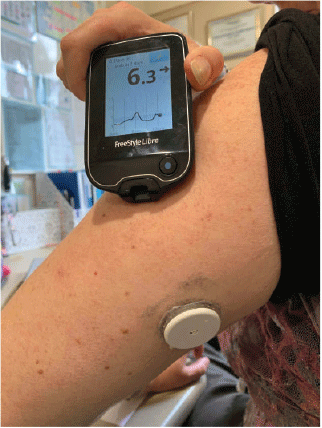
|
Participants were asked to eat only if their interstitial glucose reading was below their specified cut-off value for the day. If their interstitial glucose was above their cut-off value, participants were instructed to wait for at least 20 min before retesting (Figure 2).
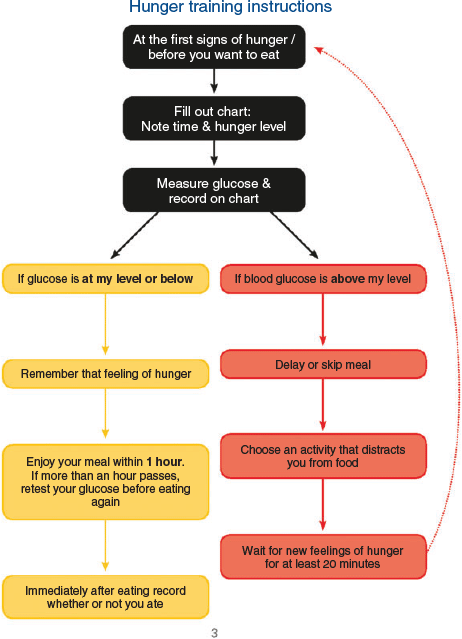
|
Participants were allowed to consume non-caloric food and beverages at any time without having to measure their glucose. They were also provided with a booklet to record their glucose readings, hunger levels using a visual scale ranging from 1 (‘starving’) to 5 (‘satisfied’), and to indicate whether food was subsequently consumed (Figure 3).
Study procedures
Participants met with researchers at baseline and on day seven. At baseline, participants were introduced to the hunger training intervention. The glucose sensor was applied to the upper arm of the participant’s choice. The second meeting included a semi-structured interview about nurses’ experience following the hunger training protocol; their opinion of the suitability of hunger training for their patients; changes they would suggest to hunger training for use in primary health care; and training and resources required to deliver hunger training (Supplementary material file). Probing questions were used to extract further detail and explanations during the interview.12 The glucose monitor was removed and participants were given a NZ$50 grocery voucher to acknowledge their participation.
All recorded interviews were professionally transcribed verbatim. Transcripts were labelled only with the participants’ study identification numbers to maintain anonymity during analysis. Transcripts were checked against digital recordings for accuracy. After all transcripts were reviewed by at least two researchers, it was clear that saturation had been reached and it was deemed unlikely that new topics would arise. Consequently, data collection was concluded.13
Analysis
The transcribed interviews were the main data source for this study. We used an inductive approach to thematic analyses that included familiarisation with the interviews, development of codes, collating codes into themes and overcoming coding conflicts between researchers.11,14,15 First, we analysed the transcripts to develop a coding guide, following grounded theory recommendations.11,16 Primary coding was then carried out independently by two researchers using NVivo version 12 (QSR International, Melbourne, Vic., Australia). Coding conflicts were discussed in person and agreed upon by at least two researchers.
To enable easy discussion of this study’s findings, we used qualifying terminology from previous studies.14,16 When a concept was discussed by <3 participants, we referred to ‘a few’; for 4–5 participants we referred to ‘some’; for 6–7 participants we referred to ‘most’; for 8–9 participants we referred to ‘almost all’; and for 10 participants, we referred to ‘all’.
Results
Ten registered nurses from four general practices participated in this study. All nurses were female, mainly NZ European (n = 8/10) and had been a registered nurse for on average 24 years (s.d. 14.8; range 6–47 years). They had a mean age of 51 years (s.d. 9.7; range 32–64 years) and a glucose cut-off of 4.9 mmol/L (s.d. 1.0).
The main themes that arose during the interviews included: experiences following hunger training; current practice; nurse interest in hunger training; anticipated patient enablers and barriers to hunger training; resources and training needed; and suggested refinements to hunger training for use in primary health care.
Nurse experience following hunger training
Nurses reflected on their experience following hunger training and commented on their adherence to the protocol, using the booklet, measuring their blood glucose and personal behaviour change. Although nurses are not the usual users of the hunger training programme, reflection on their experience gives insight into the real-life experience of people following the programme. In particular, we can use this information to identify challenges with adherence and to make more accurate patient-specific alterations to the protocol before implementation.
Almost all nurses mentioned adherence barriers. The most common barrier was attending social events while following hunger training, including drinking alcohol and eating out. A couple of nurses were initially confused about the instructions, but figured it out as the week progressed. Adherence enablers included routine and structure. For instance, some reported that work days were easier than weekends.
While a few nurses struggled to remember to complete their booklet, most participants liked filling it in daily. Some thought it was ‘well-explained’ and easy to follow, particularly the flow diagram (Figure 2). They liked the hunger scale, as it made them aware of whether they were actually hungry enough to eat (Figure 3).
All nurses reported enjoying monitoring their glucose. They found it ‘easy’ and ‘simple’, and especially appreciated that the monitor was waterproof and had a memory. Most nurses noticed how specific foods influenced their glucose:
‘I enjoyed it [hunger training], and I enjoyed the surprise of certain things putting up my blood sugar level, which I hadn’t really thought would count that much.’ [Nurse 3, 30 years’ experience]
All nurses were comfortable wearing the sensor and did not feel self-conscious about it, especially while at work. A couple of participants had cut-offs <4.0 mmol/L, which meant they had to wait longer to eat and were worried when their glucose levels dropped low. They suggested having a minimum glucose cut-off and reassuring patients that having low blood sugar was not dangerous to people who did not have diabetes:
‘When I first went below four [mmol/L] and the machine was flashing at me, saying you’re heading low, I kind of felt a bit panicked because I thought, ‘Am I going to go into a hypo or something, and is this a dangerous thing?’ Of course, the machine doesn’t say to you, you’re actually not in danger.’ [Nurse 3, 30 years’ experience]
Almost all participants reported increased awareness of hungry versus non-hungry eating. They identified triggers to non-hungry eating, including habit or time of day, food availability, social settings and emotional eating. A few participants noted that they felt hungrier during the week of hunger training, because they were eating less or waiting longer to eat due to having a cut-off glucose level that dictated when they could eat. A few nurses reported that they reduced their snacking and grazing.
Current practice of nurses and interest in hunger training
Almost all nurses explained that they currently offer their patients ‘healthy lifestyle appointments’ that incorporate nutrition and physical activity advice. Some nurses mentioned that they frequently referred their patients to see dietitians.
All nurses stated that they would like to use hunger training with their patients:
‘I think it [hunger training] would give us a lot more information to base our judgements on, our clinical judgements, but it would also give them [patients] more information.’ [Nurse 1, 7 years’ experience]
Most thought that hunger training offered a great way to educate patients on their appetite, as well as the impact of their food choices on their glucose:
‘The good thing [about hunger training] is it’s teaching you about your signals for hunger. It’s teaching you about the quality of food that you’re eating.’ [Nurse 3, 30 years’ experience]
A few nurses also commented on the potential sustainability of the hunger training programme:
‘It really teaches [patients] skills and things that they actually need to potentially be long term successful.’ [Nurse 12, 24 years’ experience]
Anticipated patient enablers and barriers to hunger training
Nurses discussed a variety of barriers and enablers to patient interest in hunger training (Table 1).
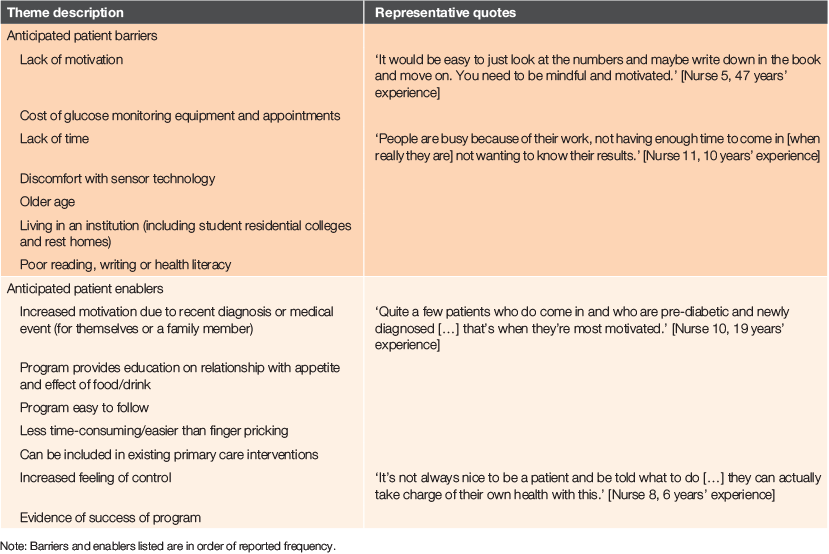
|
Resources and training
Most nurses provided suggestions to improve hunger training for use in general practices (Table 2). The main anticipated barriers they identified were a lack of motivation and financial constraints for appointments or equipment. The main anticipated enablers were increased motivation due to a recent diagnosis and that hunger training provides education on the relationship between food and drink and on a patient’s glucose response.
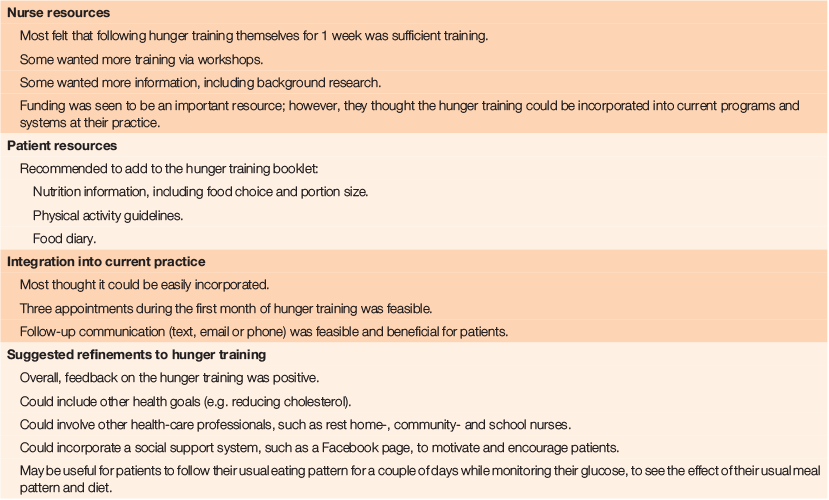
|
Discussion
This study explored practice nurse perspectives on the use of hunger training in general practices as a method of managing patients with excess weight. While the importance of knowledge translation in health care is appreciated, it is often challenging to effectively disseminate research into practice. Nurses are key actors in improving patient outcomes, so it is crucial to face this challenge by identifying the attitudes and beliefs of nurses to maximise research translation in an effective way.17
We found that participants were overwhelmingly positive about the hunger training programme, which could partially be a result of their own experience following the intervention. Positive staff attitudes have been reported as key enablers to the successful translation of research into primary care and training staff before implementing new interventions has also been reported to increase staff confidence and acceptance.18–20 Therefore, nurses’ experience of the hunger training programme acted as informal training. This may explain their confidence and acceptance of hunger training as a potential intervention in general practice. Obtaining these first perspectives from nurses who had experienced the programme is a unique component of this study that allowed us to collect information about the acceptability of hunger training and suggested refinements that could further increase the acceptability and suitability of hunger training as a general practice intervention.
Nurses spoke openly about the barriers and enablers that patients may encounter in following hunger training, but many of these barriers reflected the difficulties of weight management interventions in general, rather than specifically related to hunger training. Participants felt strongly that motivation could be both an important enabler or barrier in the acceptance and effectiveness of this intervention. This is consistent with similar studies reporting patient motivation as the key to the success of guideline and programme implementation.20–22
Financial costs, time resources and workload are well reported barriers to the implementation of interventions in primary care.21–23 Nurses in this study repeatedly commented on financial cost, most often from the perspective of patients, as a barrier to patient interest in hunger training. However, time and workload were not concerns to nurses in this study. While previous work has reported that clinicians feel that time constraints limited their ability to implement research,18–20 in this study, nurses were enthusiastic about integrating hunger training into their clinical practice. They felt that hunger training was simple and easy to follow and could save them time in managing the care of patients with obesity. This is consistent with a systematic review finding that programmes that save clinical time are more likely to be adopted.19 Coinciding with nurses’ satisfaction about the ease of hunger training, is the suggestion that the intervention can fit in with existing government-funded programmes. Combining hunger training with existing programmes may solve the financial burden of introducing a new programme into general practice and may also negate issues associated with time and workload costs. Future investigation of this solution would be amenable to participatory action research with administrators, nurses and other stakeholders working with researchers to, for example, discover which supportive behaviours practised by nurses best predicts patient success, to promote a patient-centred approach.24
Limitations to this study include that it was limited to one city in NZ and opinions of nurses may differ elsewhere. This study did, however, include nurses from four clinics, which strengthens its ability to be translated to other general practices in the South Island. While this study included only female nurse participants, this is broadly representative of the nurse population in NZ, as only 8% of nurses nationwide are male.25
This study’s strengths include the fact that participants were all experienced nurses and reported working with a variety of patients. The analysis was robust, with all transcripts double coded and group discussions on emerging themes. Finally, a main strength of this study is its focus on translational science. By understanding the perspectives of key stakeholders like nurses, accurate refinements and informed changes can be made to the hunger training programme, resulting in greater likelihood of successful implementation into general practice. Our results, alongside quantitative studies of hunger training, imply that the use of hunger training is feasible for the treatment of obesity in NZ general practices.
Funding
J.T.G. was supported by a University of Otago Summer Research Scholarship (Health Sciences). M.R.J. was supported by a University of Otago Postdoctoral Fellowship
Competing interests
The authors declare no competing interests.
References
[1] World Health Organization. Obesity and overweight fact sheet. Geneva: World Health Organization; 2016.[2] Ministry of Health. Annual Update of Key Results 2015/16 New Zealand Health Survey. Wellington: Ministry of Health; 2016.
[3] Finalyson M, Heridan NF, Cumming J. Nursing developments in primary health care 2001–2007. Wellington: Ministry of Health; 2009.
[4] Claridge R, Gray L, Stubbe M, et al. General practitioner opinion of weight management interventions in New Zealand. J Prim Health Care. 2014; 6 212–20.
| General practitioner opinion of weight management interventions in New Zealand.Crossref | GoogleScholarGoogle Scholar | 25194248PubMed |
[5] Schaefer JT, Magnuson AB. A review of interventions that promote eating by internal cues. J Acad Nutr Diet. 2014; 114 734–60.
| A review of interventions that promote eating by internal cues.Crossref | GoogleScholarGoogle Scholar | 24631111PubMed |
[6] Field AE, Inge TH, Belle SH, et al. Association of obesity subtypes in the longitudinal assessment of bariatric surgery study and 3-year postoperative weight change. Obesity. 2018; 26 1931–7.
| Association of obesity subtypes in the longitudinal assessment of bariatric surgery study and 3-year postoperative weight change.Crossref | GoogleScholarGoogle Scholar | 30421853PubMed |
[7] Jospe MR, Taylor RW, Athens J, et al. Adherence to hunger training over 6 months and the effect on weight and eating behaviour: secondary analysis of a randomised controlled trial. Nutrients. 2017; 9 1260
| Adherence to hunger training over 6 months and the effect on weight and eating behaviour: secondary analysis of a randomised controlled trial.Crossref | GoogleScholarGoogle Scholar |
[8] Barkeling B, King NA, Naslund E, Blundell JE. Characterization of obese individuals who claim to detect no relationship between their eating pattern and sensations of hunger or fullness. Int J Obes. 2007; 31 435–9.
| Characterization of obese individuals who claim to detect no relationship between their eating pattern and sensations of hunger or fullness.Crossref | GoogleScholarGoogle Scholar |
[9] Dalton M, Hollingworth S, Blundell J, et al. Weak satiety responsiveness is a reliable trait associated with hedonic risk factors for overeating among women. Nutrients. 2015; 7 7421–36.
| Weak satiety responsiveness is a reliable trait associated with hedonic risk factors for overeating among women.Crossref | GoogleScholarGoogle Scholar | 26404367PubMed |
[10] Sandelowski M. Whatever happened to qualitative description? Res Nurs Health. 2000; 23 334–40.
| Whatever happened to qualitative description?Crossref | GoogleScholarGoogle Scholar | 10940958PubMed |
[11] Strauss A, Corbin J. Basics of qualitative research: techniques and procedures for developing grounded theory, 2nd edn. Thousand Oaks, CA, USA: Sage Publications, Inc; 1998.
[12] Strack RW, Magill C, McDonagh K. Engaging youth through photovoice. Health Promot Pract. 2004; 5 49–58.
| Engaging youth through photovoice.Crossref | GoogleScholarGoogle Scholar | 14965435PubMed |
[13] Mason M. Sample size and saturation in PhD studies using qualitative interviews. Forum Qual Soc Res. 2010; 11 1–19.
[14] Ward AL, Freeman C, McGee R. The influence of transport on well-being among teenagers: a photovoice project in New Zealand. J Transp Health. 2015; 2 414–22.
| The influence of transport on well-being among teenagers: a photovoice project in New Zealand.Crossref | GoogleScholarGoogle Scholar |
[15] Thomas DR. A general inductive approach for analyzing qualitative evaluation data. Am J Eval. 2006; 27 237–46.
| A general inductive approach for analyzing qualitative evaluation data.Crossref | GoogleScholarGoogle Scholar |
[16] Simons D, Clarys P, De Bourdeaudhuij I, et al. Why do young adults choose different transport modes? A focus group study. Transp Policy. 2014; 36 151–9.
| Why do young adults choose different transport modes? A focus group study.Crossref | GoogleScholarGoogle Scholar |
[17] Curtis K, Fry M, Shaban RZ, et al. Translating research findings to clinical nursing practice. J Clin Nurs. 2017; 26 862–72.
| Translating research findings to clinical nursing practice.Crossref | GoogleScholarGoogle Scholar | 27649522PubMed |
[18] Ploeg J, Davies B, Edwards N, et al. Factors influencing best-practice guideline implementation: lessons learned from administrators, nursing staff, and project leaders. Worldviews Evid Based Nurs. 2007; 4 210–9.
| Factors influencing best-practice guideline implementation: lessons learned from administrators, nursing staff, and project leaders.Crossref | GoogleScholarGoogle Scholar | 18076464PubMed |
[19] Mathieson A, Grande G, Luker K. Strategies, facilitators and barriers to implementation of evidence-based practice in community nursing: a systematic mixed-studies review and qualitative synthesis. Prim Health Care Res Dev. 2019; 20 e6
| Strategies, facilitators and barriers to implementation of evidence-based practice in community nursing: a systematic mixed-studies review and qualitative synthesis.Crossref | GoogleScholarGoogle Scholar | 30068402PubMed |
[20] Nolan C, Deehan A, Wylie A, et al. Practice nurses and obesity: professional and practice-based factors affecting role adequacy and role legitimacy. Prim Health Care Res Dev. 2012; 13 353–63.
| Practice nurses and obesity: professional and practice-based factors affecting role adequacy and role legitimacy.Crossref | GoogleScholarGoogle Scholar | 22464138PubMed |
[21] Woodruff RC, Schauer GL, Addison AR, et al. Barriers to weight loss among community health center patients: qualitative insights from primary care providers. BMC Obes. 2016; 3 43
| Barriers to weight loss among community health center patients: qualitative insights from primary care providers.Crossref | GoogleScholarGoogle Scholar | 27785364PubMed |
[22] Nemeth LS, Rice LJ, Potts M, et al. Priorities and preferences for weight management and cardiovascular risk reduction in primary care. Fam Community Health. 2017; 40 245–52.
| Priorities and preferences for weight management and cardiovascular risk reduction in primary care.Crossref | GoogleScholarGoogle Scholar | 28525445PubMed |
[23] Ayres CG, Griffith HM. Perceived barriers to and facilitators of the implementation of priority clinical preventive services guidelines. Am J Manag Care. 2007; 13 150–5.
| 17335358PubMed |
[24] Ivankova NV. Applying mixed methods in community-based participatory action research: a framework for engaging stakeholders with research as a means for promoting patient-centredness. J Res Nurs. 2017; 22 282–94.
| Applying mixed methods in community-based participatory action research: a framework for engaging stakeholders with research as a means for promoting patient-centredness.Crossref | GoogleScholarGoogle Scholar |
[25] Nursing Council of New Zealand. The New Zealand Nursing Workforce. Wellington, NZ: Nursing Council of New Zealand; 2011.


